Application and guidance for providers holding a 2022 Standard Crime Contract
Introduction
Part 3, Sections 28 – 29 of the Domestic Abuse Act 2021 allows the police to apply to the Magistrates Court for a Domestic Abuse Protection Order to protect a victim from domestic abuse. The application to the Magistrates Court will be made after the police have previously issued a Domestic Abuse Protection Notice to the alleged perpetrator of the abuse. These cases are in scope for civil funding pursuant to Schedule 1, Part 1, paragraph 11 of the Legal Aid, Sentencing and Punishment of Offenders Act 2012. This includes applications to vary an injunction and appeals to the Crown Court. Please note, the civil legal services prescribed under Part 1 are subject to the exclusions in Parts 2 and 3 of Schedule 1.
In this guidance these injunctions are referred to as DAPOs. This guidance has been developed to support providers who are less familiar with the civil legal aid application process. The document applies specifically to providers holding a 2022 Standard Crime Contract in relation to proceedings in the Magistrates Court.
Funding for DAPOs is provided as part of civil legal aid.
There are significant differences from criminal legal aid to keep in mind in the application process and when managing a case.
To represent a client in DAPO proceedings you must:
- be authorised to undertake civil legal aid
- apply for a civil legal aid certificate
Applications for civil legal aid must be submitted via the Client and Cost Management System (CCMS) if you hold a 2022 Standard Crime Contract.
The merits test is central to the application for legal aid. This must be addressed in detail to satisfy the relevant criteria and demonstrate the client’s financial eligibility.
Funding requests can be made as emergency applications where appropriate and can be backdated where the provisions of Civil Legal Aid (Procedure)(Amendment) Regulations 2019 are met. Further information on emergency funding can be found on page 4 Backdating requires that urgent work had to be undertaken immediately or at short notice, and the application was made at the first opportunity. Further information and guidance on backdating provisions is available at: Civil news: discretionary backdating powers on civil applications – GOV.UK (www.gov.uk).
Providers holding a 2022 Standard Crime Contract
Getting setup on CCMS
Registering a user and granting access to CCMS
The following quick guide link provides the step-by-step process for creating a new user and giving them access to CCMS. Please note, this can only be done by a user with the CCMS Firm Administrator role.
Register a user and grant access to CCMS
Granting CCMS access to an existing user
If you already have an LAA Online Account, for example, because you use eForms or CWA, our Online Support Team can amend your account and provide you with access to CCMS.
Email: Online-Support@justice.gov.uk
Telephone: 0300 200 2020
You can also use our webchat service.
Before contacting the Online Support Team, you will need to have obtained authorisation from your Contract Manager or firm’s director via email.
The following Quick Guide outlines how your CCMS Firm Administrator can do this on your behalf.
Granting CCMS access to an existing user
Registering a user and granting access to CCMS – no CCMS Firm Administrator
If you do not have a CCMS Firm Administrator, for example, because they have left employment, the Online Support Team will be able to assist you with creating a LAA Online Account. You will also need to have obtained authorisation from your Contract Manager or firm’s director via email.
We will email your login details once an account has been created, at which point you will be able to assign permissions to CCMS.
Check the appropriate User roles and responsibilities have been assigned once an account has been created.
Starting an application for legal aid
Once your user account has been created, visit the LAA Online Account and select Client and Cost Management System.
From the Home screen select ‘New Application’.
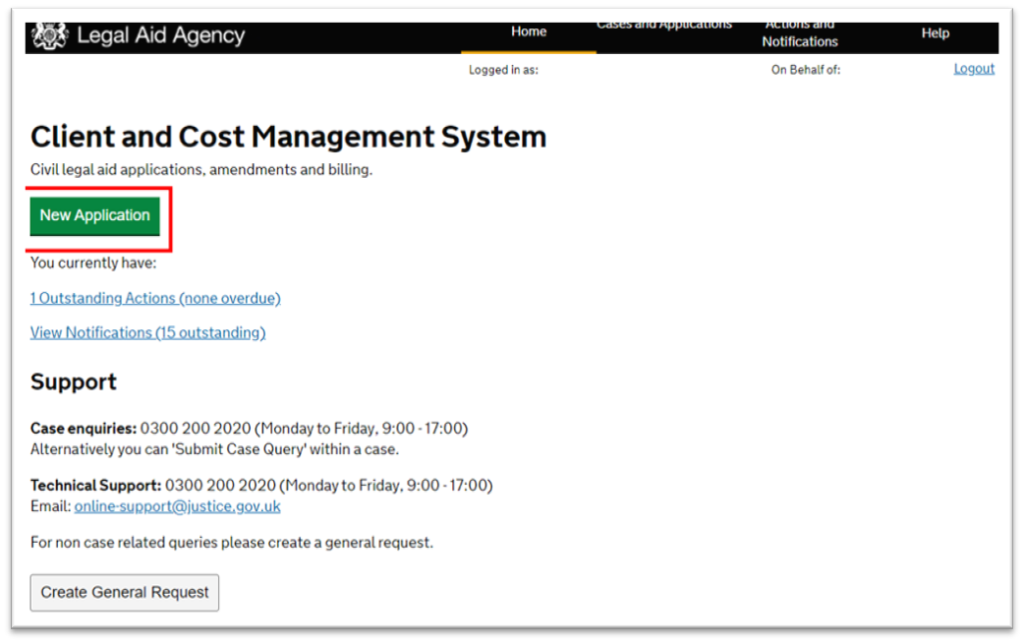
Select your office from the drop-down menu and press ‘Next’.
If you hold a Crime contract, select Crime-Civil as the category of law and press ‘Next’.
If you hold a Civil contract, select Family (for DAPOs being heard in Family Courts) or Residual for DAPOs being heard in County Courts) as the category of law and press ‘Next.’
You will need to decide whether to make an Emergency or Substantive Application for legal aid.
Emergency Representation
Applications for emergency representation must satisfy the interests of justice test. Further information is available at paragraphs 7.28 – 7.30 Lord Chancellor’s Guidance under Section 4 of the Legal Aid, Sentencing and Punishment of Offenders Act 2012.
Emergency civil legal aid certificates are limited to the urgent necessary steps in the proceedings. They cannot be extended beyond an 8-week time limitation.
If you apply for emergency representation and receive an emergency civil legal aid certificate you will need to make a Substantive Amendment for a full certificate. This is a requirement even where the work is concluded within the scope of emergency representation.
Emergency representation can be granted under delegated functions in DAPO proceedings. Delegated functions enables you to grant emergency representation for your client before the LAA has made a determination.
More information on making an emergency application can be accessed using the following link: Emergency
non delegated functions applications
Answer the question in relation to the use of Delegated Functions and press ‘Next’.
You will need to complete a Client Search to check if your client is registered within the LAA system. Mandatory fields are your client’s first name, surname at birth and date of birth. You may also include a unique identifier in the search, for example, your client’s National Insurance Number.
Once the fields have been completed press Search.
If the search returns no results you will need to select ‘Register New Client’. You will be presented with a privacy notice on the next screen. Tick the box to confirm your client or their representative has read and agreed to the privacy notice and press ‘Next’.
You will need to enter Basic Client Details. The mandatory fields are Title, Surname, Country of Origin and Marital Status. Select ‘Next’ once entered.
You will need to enter Client Contact Details. The mandatory fields are at least one contact telephone number, password/password reminder, and correspondence method. We will use the password information to verify your client’s identity if they contact us. Select ‘Next’ once details have been entered.
You will need to provide Client Address Details. You may tick the box if your client is of no fixed abode. Once details have been entered select ‘Next’.
You will need to enter Equal Opportunities Monitoring information. This includes an option to provide details of any special requirements your client may have. Select ‘Next’ once details have been entered.
You will be taken to the Summary of Client Information screen. You should review the information provided and edit details if necessary. Select ‘Submit Client’ once the information has been checked.
At the Submission Confirmation screen select ‘Next’ to start completion of the application for legal aid.
Completing the application sections
You will be presented with the Application Summary screen.
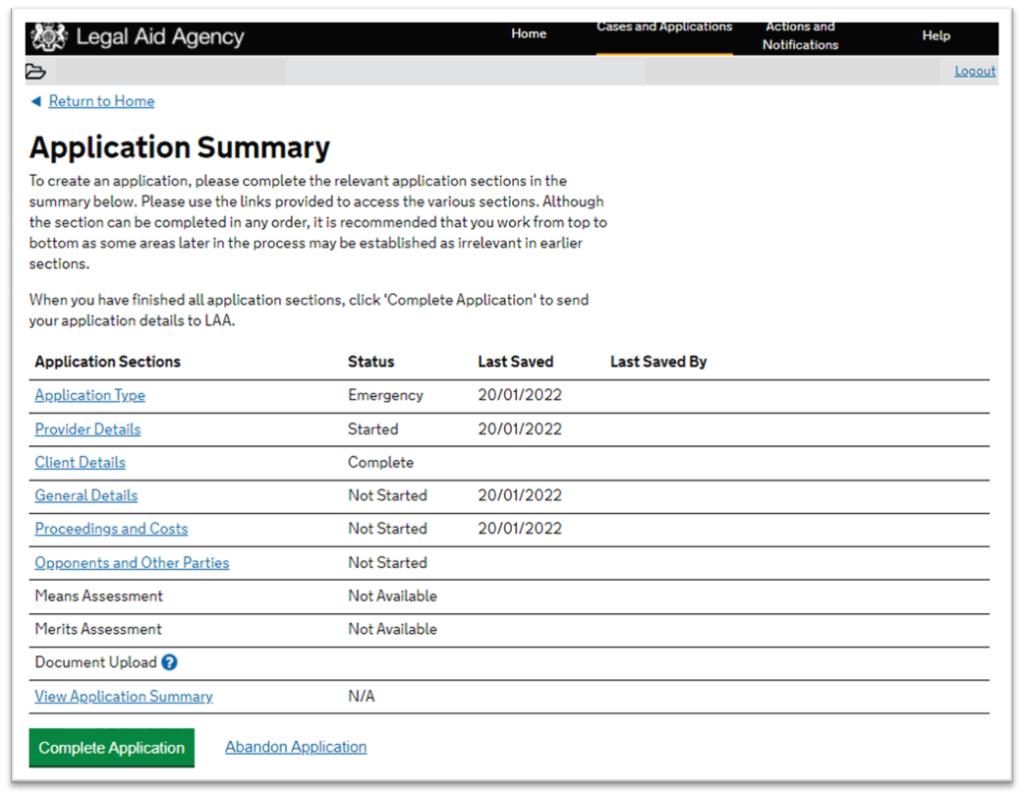
The application type and client details have already been completed based on the information supplied. The remaining sections will need to be completed before the application can be submitted.
Select Provider Details to supply the fee earner’s details and the Contact Name for the application. Once the details have been completed select ‘Confirm’.
The Application Summary screen will now be updated to show a Complete status against Provider Details.
Select General Details to complete the next section of the application. You will be asked to confirm the Correspondence Address details for your client. Select ‘Next’ once details have been entered.
You will be taken to the Linked Cases Summary screen. You will be able to link this application to other cases if you represent other parties within the same proceedings. Please refer to Linking Cases for more information on linking cases. If you do not wish to link the application to other cases, select ‘Confirm’.
The Application Summary screen will now be updated to show a Complete status against General Details.
Select Proceedings and Costs to complete the next section of the application.
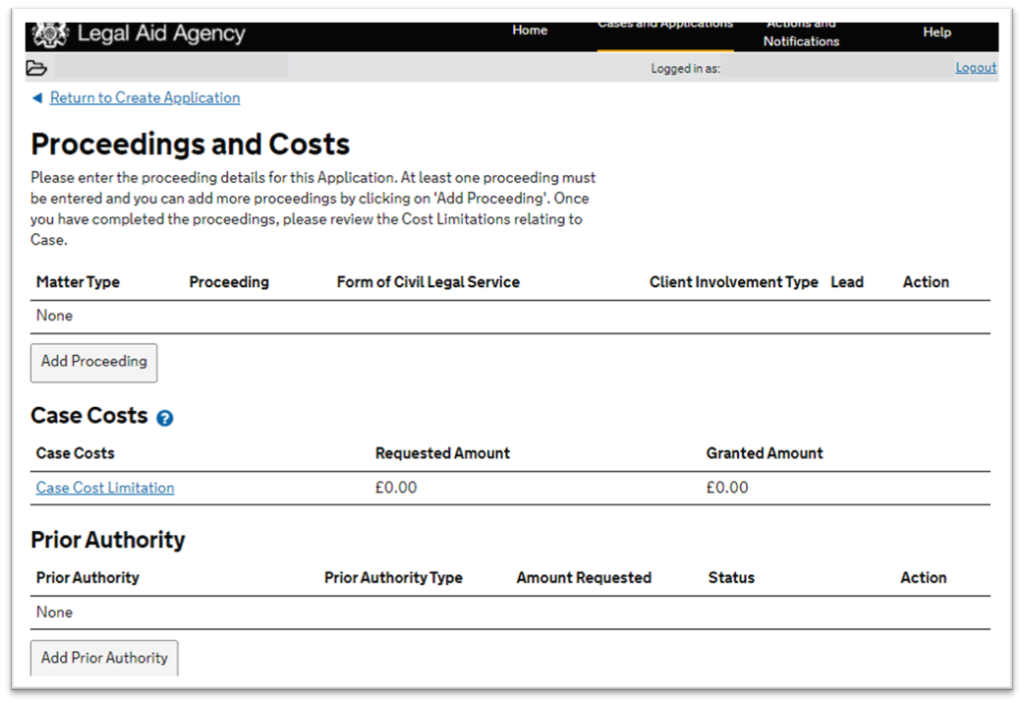
Select ‘Add Proceeding’. From the Matter Type drop-down menu select Crime Civil and select ‘Next’.
From the Proceeding drop-down menu select Domestic Abuse Protection Order – Crime Civil and select ‘Next’. If it concerns an application to vary or discharge an existing order select Vary/Discharge Domestic Abuse Order – Crime Civil.
Select Defendant/Respondent as the Client Involvement and Full Representation as the Form of Civil Legal Service. Select ‘Next’.
CCMS will add the default scope limitation of Injunction – DAPO – to final hearing.
Select ‘Next’ to return to the Proceeding Details screen. It will not be necessary to add a further Scope Limitation. Select ‘Return to Create Application’ to confirm the Scope Limitation details.
Select Opponents and Other Parties. Select ‘Add Organisation’ and complete the details to perform a search. If your search returns a match you can select ‘Use this record’ to add the organisation as the opponent. Alternatively, you may select the option Create New Organisation. Once you have selected the opponent you will need to provide details of their relationship to the case and your client from the two drop-down menus. Select ‘Confirm’ once completed.
If you do not need to add any further Opponents and Other Parties, select ‘Return to Create Application’.
Means and Merits Assessments
The Means Assessment and Merits Assessment options are now available for completion.
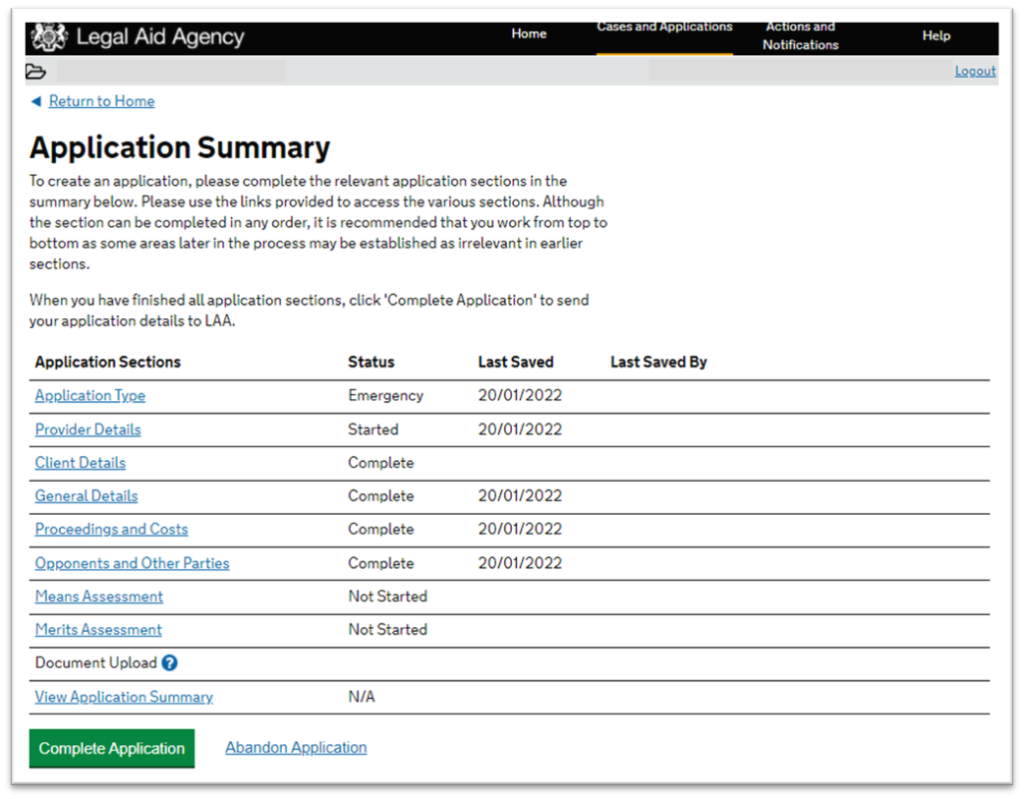
Please refer to Means assessment information for guidance on completing the Means Assessment.
Next you will need to complete the Merits Assessment. CCMS will ask questions regarding the merits of the case.
You will be asked if you are making an urgent application. If you select ‘yes’ you will need to provide a description of the urgency. Once completed select ‘Next’.
If you have not exercised delegated functions on an Emergency Application, you will be asked be asked the reason why. Select ‘Next’ once this field has been completed.
You will be asked whether your client has previously received legal aid and the reasons why your client is applying for representation. Select ‘Next’ once completed.
You will be asked to provide General Details about the case, including the date your client first visited your firm, the main purpose of the application, and the number of clients you are representing in the proceedings. Select ‘Next’ once completed.
You will be asked whether proceedings are currently before the court. If proceedings have been issued answer ‘Yes’ and complete the fields. Select ‘Next’ once complete.
You will be asked if the case has been listed for a final contested hearing. Select ‘Next’ once complete.
You will be asked if the client requires separate representation from other parties in the proceedings. Select ‘Next’ once complete.
You will be asked a series of questions to help CCMS route the application to the appropriate LAA team. This includes:
You will be asked to provide details of alternative funding. This includes answering questions about whether other persons might benefit from the proceedings who can reasonably be expected to fund the case. You will also need to answer questions about any insurance policies held by the client. You will be prompted to provide specific answers to questions about After the Event Insurance (AFE) and Conditional Fee Arrangements CFA). You should complete both boxes explaining the proceedings are unsuitable for AFE and CFA. Select ‘Next’ once complete.
You will be asked to provide information about your client’s likely prospects of success. Select ‘Next’ once complete.
Prospects of success
Prospects of success means the likelihood that your client will obtain a successful outcome at trial or other final hearing.
Successful outcome means the outcome a reasonable individual would intend to achieve in the proceedings in all the circumstances of the case.
For further information on assessing prospects of success refer to Regulations 4 and 5 of the Civil Legal Aid (Merits Criteria) Regulations 2013 and paragraph 4.1 Lord Chancellor’s Guidance Under Section 4 of LASPO 2012.
You will be asked to provide details of your estimated costs to trial (excluding VAT). Select ‘Next’ once all questions have been answered.
You will be asked to confirm why this matter is considered proportionate for the purposes of the regulations. Select ‘Next’ once details have been provided.
You will need to assess whether the case is of overwhelming importance to your client, for example, if the case concerns life, liberty, or physical safety. You will also need to confirm if you are contending that the case has human right elements. If so, you will to provide details of the articles your client will rely upon. Select ‘Next’ once complete.
You will need to provide your client’s statement of case. You can either complete the statement of case fields or upload an attachment on the next screen.
Statement of Case
Applications for civil legal aid must satisfy the requirements set out in the Civil Legal Aid (Merits Criteria) Regulations 2013. In particular you will need to satisfy Regulation 67. The application for civil legal aid is merits tested, and your statement of case must provide sufficient information to demonstrate those requirements are met.
Applications for civil legal aid in domestic abuse protection order proceedings in the magistrate’s court will need to satisfy the ‘proportionality’ test. You will need to show that the likely benefit to be gained from the provision of civil legal services justifies the likely costs, having regard to the prospects of success and all the other circumstances of the case.
The statement of case will need to provide details of what your client is trying to achieve and a reasoned argument as to the prospects of achieving that aim. This should include details of your client’s response to the allegations.
Your statement of case should also confirm which pilot area you are operating within.
You can access the Civil Legal Aid (Merits) Regulations via this link.
Once you have provided your client’s statement of case you will be asked whether you would like to provide additional supporting documents.
You will be asked to provide confirmation that your client will sign the relevant declaration prior to submission of the application. There is space to provide an explanation if the declaration will not be obtained before submission. You will also be asked to confirm that you have explained the implications of the certificate being revoked to your client.
Revocation may occur if your client fails to comply with requests for information on the assessment of this financial eligibility. If funding is revoked, they will become liable for any costs incurred under the emergency civil legal aid certificate.
You will be taken to the Merits Declaration page. Tick the box to confirm the client, or their representative, has read and understood the declaration. Select Complete on the next screen.
You will be presented with an Assessment Summary. Check the details provided are accurate and select Confirm.
Once the Means and Merits Assessments have been completed you can select the option ‘Document Upload’.
CCMS will display details of the documents you need to provide based on the information supplied in the Means and Merits Assessments. You will see Yes/No options for each item, allowing you to indicate whether you wish to upload the documents with the submission of your application. Once ‘Yes’ is selected you will be presented with the ability to select files from your computer. You will need to indicate which document is being uploaded from the Document Type drop-down list. There is also an option to provide a Document Description.
You do not have to upload documents at this point. If the application is submitted without documents, we will send you a notification to supply them separately. Please note, we will be unable to consider your application for legal aid until the documents have been provided.
Please refer to the Submitting electronic evidence guide if you require further support.

Except for the Application Type, each of the Application Sections should now show a Complete status.
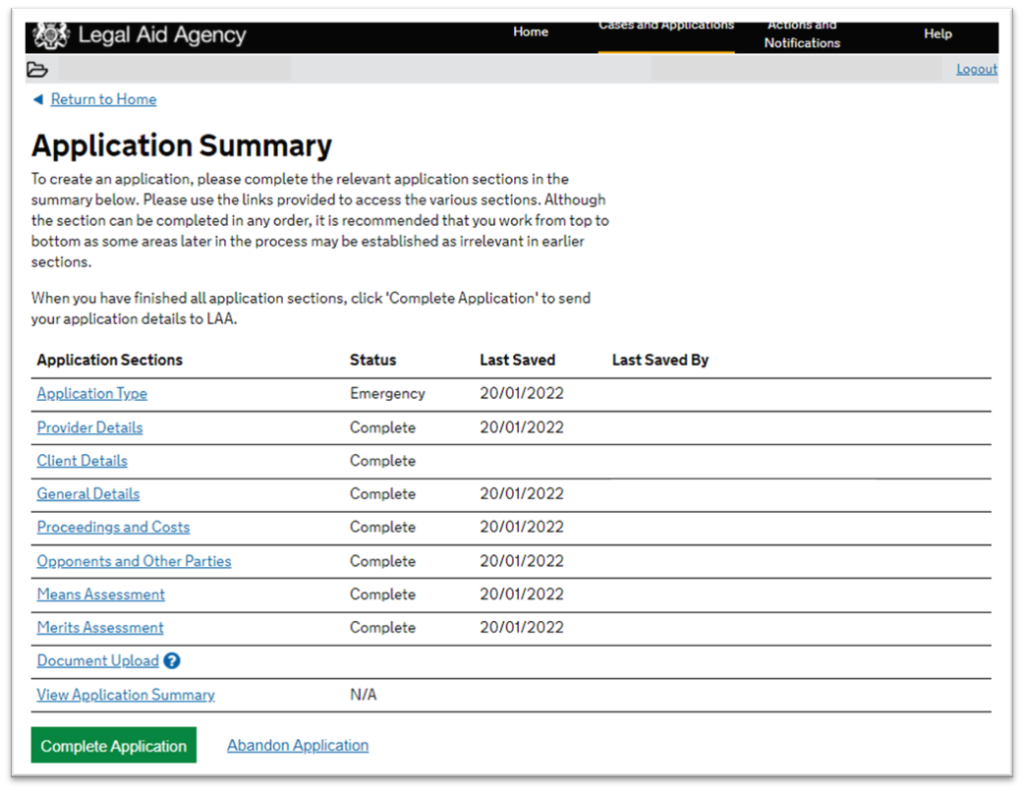
Select Complete Application, which will take you to the Application Summary Screen. Review the details provided and select Back at the bottom of the screen if you identify any entries which need amending. If the details provided are correct you should select the Print option to access a copy of the Application Summary. Your client will be required to sign the printed version of the summary, which should be retained on file for auditing purposes.

Select ‘Next’ once you have printed a copy of the Application Summary. You will need to tick the box to confirm you have obtained the necessary signed declaration from your client for retention on the client’s file. Select Continue to complete the submission of your client’s application for funding.
Managing live cases
The Legal Aid Agency (LAA) will issue a funding certificate if the relevant merits and financial eligibility criteria are satisfied. Funding certificates are effective from the date of issue, although there are provisions to request the backdating of a determination. See page 2 for further information on backdating provisions.
The funding certificate will specify the proceeding for which funding can be provided to your client. It will also contain scope and costs limitations, which differs from funding issued in criminal proceedings.
The scope limitation specifies the point in the proceedings within which you are authorised to represent your client. Once that limitation has been reached you must seek an extension to the scope of the certificate to continue providing representation.
Costs limitations work similarly. The default costs limitation is £5,000 excluding VAT. This covers profit costs, disbursements and counsel fees. You will need to apply for an amendment to increase the cost limitation. Amendment requests to increase costs limitations should include details of the costs incurred to date and an explanation of how future additional costs have been calculated.
Guidance on how to submit Amendments using CCMS can be located here.